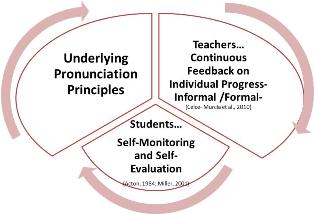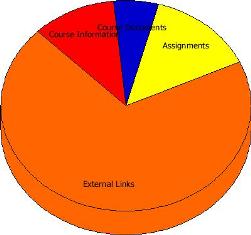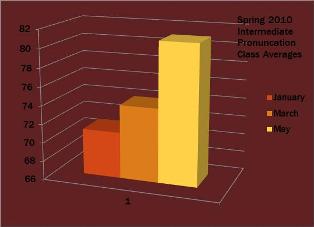|
Assessing progress in pronunciation can be very challenging.
How can teachers tell if a student is progressing with his or her
pronunciation? Celce-Murcia, Brinton, and Goodwin (2010) believe that
the teacher needs to provide ongoing informal feedback on individual
progress to support each learner during instruction. They consider this
to be a key issue in the teaching of pronunciation. In addition, many
prominent practitioners (Acton, 1984; Miller, 2001) believe that
students should be involved in evaluating their own progress. Should
pronunciation instructors use and integrate this knowledge to test and
track pronunciation progress?
One of the challenges we face in assisting students with their
pronunciation is helping them “see” the progress they are making. This
can be a daunting task because speech is typically an auditory task and
it is difficult to provide a visual representation of auditory
information. If we can find ways to do this, students will have concrete
visual methods for measuring their pronunciation progress and success.
MULTIPLE METHODS

It seems crucial to integrate the underlying pronunciation
principles of the research above into our tracking methods to make them
more efficient and effective. To create a solid foundation, we must
attempt to utilize students’ self-monitoring and teachers’ continuous
feedback for successfully tracking student progress in pronunciation.
Some effective and efficient methods of tracking pronunciation progress
utilize a variety of formats: written, oral, audio, recordings,
software, and other technology.
We need to assess students’ current levels to create a baseline
of their pronunciation and to help them construct a clear vision to
achieve their personal goals. It is important to keep in mind both
expressive (their ability to actually say the words or use pronunciation
features) and receptive (their ability to understand the different
features and discriminate between them) speaking skills.
DIAGNOSTIC DECISIONS: EXPRESSIVE AND RECEPTIVE PRONUNCIATION
Looking at students’ ability to produce speech, we need to make
numerous decisions and consider different speaking styles that can be
used. Practices that have been used for assessment and tracking include
imitative, prearranged, spontaneous, and self-monitored speech. Each of
these practices has its own inherent pros and cons.
Examples of Styles
Imitation. The student imitates the
examiner’s speech. This produces results that focus more on the ability
of the student to correctly repeat a given stimuli than the typical
speech productions they use independently.
Prearranged. The student is examined and
prompted on a specific and possibly limited corpus of tasks. This may be
a reading task in which spelling can influence pronunciation or create a
narrow testing scope.
Spontaneous. The student is assessed based
on more natural and unplanned speaking tasks. This may not lead to all
the target sounds being produced and may not provide a comprehensive
enough picture.
Self-Monitored. The student completes
speaking tasks in which he or she can engage in self-analysis before the
task is completed or submitted. Students may make changes to their
speech sample before the examiner has an opportunity to observe the
typical patterns they are using.
We also need to decide if we utilize assessment tools that
specifically look at just sounds/phonemes, words, sentences, or
connected speech, or a combination of all of these.
The pronunciation teacher can create a profile for each student
based on assessment results. This profile may include a visual
representation of the student’s skills in concrete terms (test scores or
numbers) for the selected receptive pronunciation features. In
addition, it may list specific sounds/phonemes that a student had
difficulty with during the assessment. An overall test score can be
compared to the total possible score. This will help students actually
see their starting points by comparing the numbers of their
pronunciation performance to the total possible number they could
achieve. Consider including the following components: consonant
production, consonant discrimination, vowel production, vowel
discrimination, syllables, word stress, sentence stress, focus words,
thought groups, connected speech, and
intonation.
MEASURING “TALKING” SUCCESS
Measuring a student’s progress is not easy. Nevertheless, if
students acknowledge some of their strengths and choose specific targets
to work on, it will help create a visual representation of their
individual goals and establish a starting point to track their success.
The pronunciation teacher can consider whether or not the
pronunciation textbook he or she is using has an assessment piece that
accompanies it, such as Clear Speech by Judy B.
Gilbert (2007) or Targeting Pronunciation by Sue
Miller (2008).
Teachers can also create their own pronunciation profile forms
to go along with these assessments. These forms should integrate both
receptive and expressive pronunciation components, along with the
ability to retest and write the scores or information two times after
the initial baseline testing, creating pre- and posttest capability.
This will yield valuable data regardless of the length of time students
participate in pronunciation classes. It is important to have the
students choose their own goals or target areas after reviewing the
results on their profiles because they have to work toward achieving
these goals and it is in the teachers’ best interest that they be highly
motivated.
SELF-RECORDINGS
In addition to seeing the progress by looking at pronunciation
scores as we test and retest, we should also utilize the auditory
component. This can be achieved by having students record samples of
their speech in the first week of class before they start learning the
specific pronunciation techniques, and recording again in the last week
to compare the samples. The difference is often remarkable. Sometimes
more time is needed to hear a marked difference; still, it is useful to
utilize this technique as one of the many methods of tracking students’
progress.
Depending on the language level of the student, it is important
to consider the levels of complexity of the recording tasks (see Figure
1).
Figure 1. Recording Tasks’ Complexity
|
Lower Levels |
Upper Levels |
|
Short Introduction |
Detailed Introduction |
|
Basic Intonation Patterns |
Storytelling Picture Tasks |
|
Numbers |
Specific Open-ended Topics |
|
Reading One Paragraph |
Reading Multiple Paragraphs |
|
Short Sentences |
Connected Speech |
Teachers can share instructions with students on how they can
record themselves speaking using any of the following: personal
computers, language lab computers, campus PCs, smartphones, iPhones, tablets, and
iPads. Most computers have a sound recorder feature or students can
download a free voice recording program such as Audacity.com. After they
record their sample, they can save it as an MP3 or wav file and attach
it to an e-mail to their instructor or upload it to
Blackboard.
TRACKING METHODS
Methods used to track pronunciation progress include Blackboard
and software tracking, phone and computer recordings, pre/posttests,
and pronunciation logbooks.
One way of tracking students’ pronunciation progress is
Blackboard. The instructor can provide specific Internet sites for the
students to practice their targets with links and descriptions for
students on Blackboard. I provide five to six sites. Each time they
practice on a site, the teacher is able to secretly track them and see
how often they are practicing and even which sites they are practicing
on most frequently. In Figure 2 you can see that the students accessed
the external links for practicing with pronunciation sites 279 times
during this 4-week time period.

Figure 2. General Blackboard Tracking
|
Folder |
Hits |
Percent |
|
Course Information |
44 |
10.26% |
|
Course Documents |
23 |
5.36% |
|
Assignments |
56 |
13.05% |
|
External Links |
279 |
65.03% |
|
Total |
429 |
100% |
The teacher can access the Blackboard tracking information by
clicking on Control Panel>Course Statistics>Select Report:
Accesses by Content Area>Time Period: your choice>Users:
select all users.
Teachers can track the number of times each student individually practices on each site by looking at the
external links column. In Figure 3, on the left you will see the
student’s initials and by following that row horizontally to “external
links” you can identify and track how many times that student practiced.
Note that the student with initials D.A. practiced 80 times and the
student with initials L.S. didn’t practice at all. Teachers can also
access charts that show the specific time of day and days of the week
the student practiced, as well as sites used by each student.
Figure 3. Blackboard Tracking of Individual Students
|
Course
Information |
Course
Documents |
Assignments |
External Links |
Total |
|
OB |
2 |
1 |
2 |
7 |
12 |
|
DB |
0 |
0 |
0 |
14 |
14 |
|
DA |
2 |
3 |
7 |
80 |
92 |
|
GD |
1 |
1 |
9 |
17 |
28 |
|
KY |
1 |
0 |
0 |
5 |
6 |
|
KE |
1 |
1 |
2 |
4 |
8 |
|
LS |
1 |
0 |
1 |
0 |
2 |
|
LY |
2 |
1 |
5 |
1 |
9 |
|
CM |
7 |
1 |
2 |
12 |
22 |
|
NN |
0 |
0 |
2 |
3 |
5 |
|
NU |
6 |
4 |
5 |
7 |
22 |
|
JP |
2 |
2 |
2 |
9 |
15 |
|
PQ |
1 |
1 |
3 |
28 |
33 |
|
PD |
3 |
3 |
3 |
47 |
56 |
|
VI |
2 |
0 |
0 |
28 |
30 |
|
XP |
1 |
0 |
1 |
3 |
5 |
|
YH |
12 |
5 |
11 |
6 |
34 |
|
ZX |
0 |
0 |
1 |
8 |
9 |
|
Total |
44 |
23 |
56 |
279 |
429 |
When students are not progressing and we can see that they have
not practiced, we have evidence to show them why they might not be
progressing. We may want to recognize and positively reinforce the
individual students who are practicing. For example, I have posted
announcements on Blackboard congratulating those participating students
for their hard work and practice. It can make a significant
difference.
SOFTWARE TRACKING
Another method of tracking that can be utilized is
pronunciation software with tracking features. Many different kinds are
available. At our IEP, we have American
Speechsounds software in our language lab. With this program,
students track themselves by writing down results in a log during class
or during additional practice times while practicing specific
pronunciation exercises. They can also record their own voices and
compare themselves to the speech models using the important principle of
self-monitoring.
PRONUNCIATION LOGBOOK TRACKING
Some pronunciation textbooks, such as Sound
Concepts by Marnie Reed and Christina Michaud (2005), include
pronunciation logs so that students can track their errors based on
teacher feedback. Writing it down helps both students and instructors
see if there are any patterns as to the type of error
or frequency of error. As students begin to analyze
their individual and unique pronunciation patterns, they can begin to
make changes. This kind of insight or self-awareness seems to apply to
many skills we learn in life. For example, during class practice, one
student may notice that the teacher’s feedback focused on that student’s
difficulty using the /r/ sounds at the right time and the /l/ sound was
often used instead. Another student may learn that he or she
unintentionally adds vowels in places that they don’t exist (epenthesis)
like saying “bulue” instead of “blue,” and yet another student may gain
awareness that he or she deletes final consonants while speaking. A
pronunciation logbook can help each student by providing detailed
specific teacher feedback about his or her pronunciation and also aid in
the process of self-analysis. This allows students to see if there is a
pronunciation pattern of types and frequency used when they speak. My
students use this log as well as other logs that I have created that
emphasize specific pronunciation features such as stress, focus words,
thought groups, and American style intonation.
SHARING RESULTS
Results need to be shared to be effective. For students to
“see” progress accurately after testing, the results need to be
collective. Along with individual detailed profiles, we can create
general class profiles to share. This allows students to compare their
performance to an average (see Figure 4).
Figure 4. Fall 2010, Intermediate Pronunciation, Class Averages
Pronunciation Test (Total Possible = 100 points)
August December
65.8% correct 82.5% correct

Implementing all these effective methods of tracking in
teaching contexts can help students succeed in learning pronunciation.
Which methods will you use to successfully track your students’
pronunciation progress?
RESOURCES: TEXTBOOKS FOR CLASSROOMS
Miller, S. F. (2007). Targeting
Pronunciation: Communicating Clearly in
English (2nd ed.). Thomson Place, Boston, MA:
Heinle.
Gilbert, J. B. (2008). Clear speech: Pronunciation and listening comprehension in North American
English. New York: Cambridge University Press.
Reed, M., and Michaud, C. (2005). Sound Concepts: An
Integrated Pronunciation Course. New York, NY:
McGraw-Hill.
REFERENCES
Acton, W. (1984). Changing fossilized pronunciation. TESOL Quarterly, 18(1),
71-85.
Celce-Murcia, M., Brinton, D., & Goodwin, J. (2010). Teaching Pronunciation: A Course Book and
Reference Guide (2nd ed.). Cambridge,
England: Cambridge University Press.
Miller, S. (2001).
Self-monitoring, self-help, and the route to intelligible speech. The CATESOL Journal, 13(1), 173-182.
Catherine Moore M.A.CCC-SLP is honored to be a faculty
member for the American Language Program at California State
University, Fullerton. She is a licensed Speech Pathologist with a
Certification in Clinical Competence awarded by the American Speech
Language Hearing Association. Catherine has presented internationally in
Cambodia as a People to People Ambassador and most recently was invited
to speak in Sao Paulo, Brazil. | 
